Welcome to Olympic National Park, a hiker’s paradise! With its diverse landscapes, from lush rainforests to majestic mountains and stunning beaches, this national park offers a wealth of hiking opportunities for outdoor enthusiasts. Whether you’re a beginner or an experienced hiker, there’s something for everyone to explore and enjoy.
As you plan your hiking adventure in Olympic National Park, it’s important to come prepared with the right essentials and consider the seasonal conditions. In this guide, I will provide you with valuable tips and insights about the best hiking trails, safety measures, and fascinating features that make this park so unique.
Key Takeaways:
- Discover a range of hiking trails suitable for all levels of experience and fitness.
- Pack the essential gear and plan your hike based on the seasonal conditions.
- Explore the historical significance and geological wonders of Olympic National Park.
- Observe the abundant wildlife and capture breathtaking views from scenic viewpoints.
- Ensure your safety by following hiking tips and practicing responsible outdoor behavior.
Easy Hiking Trails in Olympic National Park
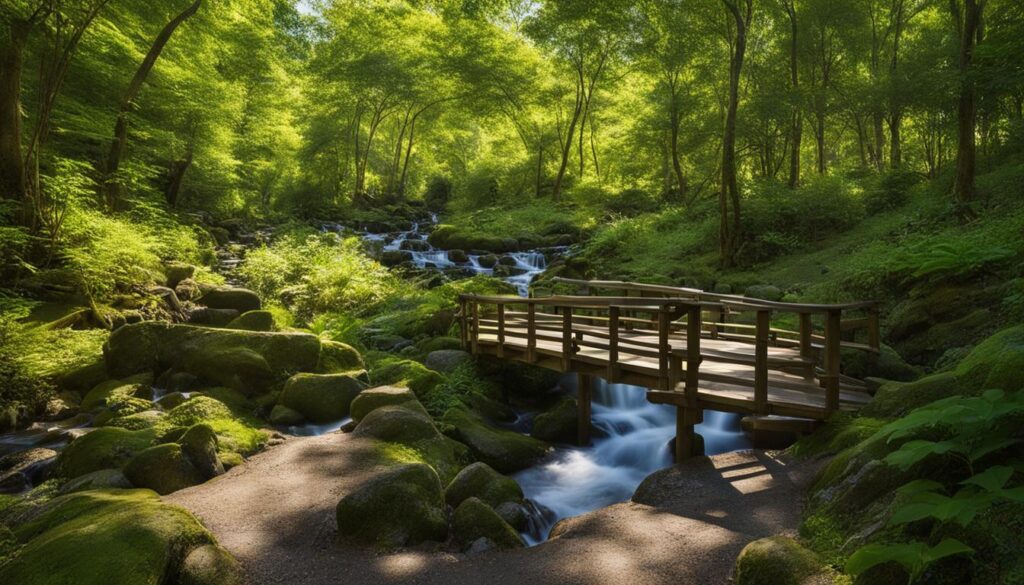
If you’re looking for a leisurely hike in Olympic National Park, you’re in luck! The park offers several easy hiking trails that are perfect for visitors of all ages and fitness levels. These trails showcase the park’s stunning natural beauty while providing a more relaxed hiking experience. Let me introduce you to some of the best hikes in Olympic National Park:
Hurricane Hill Trail
This scenic trail offers breathtaking panoramic views of the Olympic Mountains. With a relatively gentle incline, it’s accessible for most hikers. The trailhead is located near the Hurricane Ridge Visitor Center, and the 3.2-mile round trip takes you through alpine meadows filled with wildflowers during the summer months.
Sol Duc Falls Trail
For a tranquil and enchanting hike, the Sol Duc Falls Trail is a great choice. This 1.6-mile trail takes you through the lush forests of Olympic National Park and leads to a spectacular waterfall. The trail is well-maintained and offers plenty of opportunities to spot wildlife along the way.
Hall of Mosses Trail
Immerse yourself in the magical atmosphere of the Hoh Rain Forest with a hike along the Hall of Mosses Trail. This easy 0.8-mile loop takes you through a dense forest filled with towering trees covered in moss. It’s a short but unforgettable hike that showcases the unique beauty of Olympic National Park.
So, whether you’re a beginner hiker or simply looking for a more relaxed outdoor adventure, these easy hiking trails in Olympic National Park are sure to delight and inspire you. Lace up your hiking boots, grab your camera, and get ready to explore the natural wonders of this incredible park!
| Trail Name | Difficulty | Distance | Features |
|---|---|---|---|
| Hurricane Hill Trail | Easy | 3.2 miles (round trip) | Panoramic views of Olympic Mountains, wildflowers |
| Sol Duc Falls Trail | Easy | 1.6 miles (round trip) | Lush forests, stunning waterfall |
| Hall of Mosses Trail | Easy | 0.8 miles (loop) | Moss-covered trees, magical atmosphere |
Hard Hiking Trails in Olympic National Park
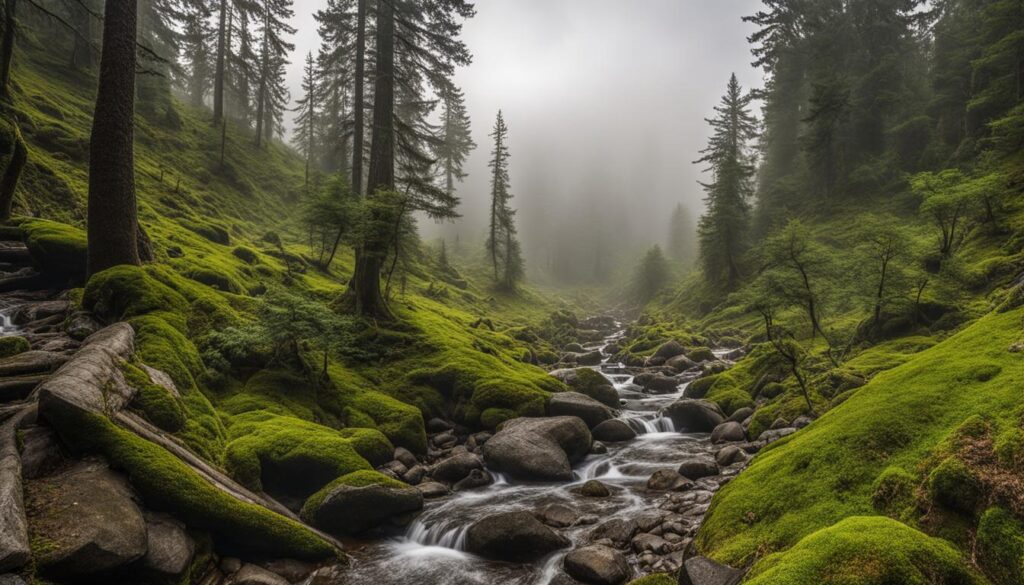
If you’re an experienced hiker seeking a challenge, Olympic National Park has several difficult trails that will test your skills and endurance. These trails offer breathtaking views and the opportunity to explore rugged terrain in one of the most diverse national parks in the United States.
Mount Ellinor Trail
One of the most challenging hikes in Olympic National Park is the Mount Ellinor Trail. This trail takes you to the summit of Mount Ellinor, offering incredible panoramic views of the surrounding Olympic Mountains. However, be prepared for steep inclines and rugged terrain along the way. It’s important to have proper hiking gear and be in good physical condition before attempting this trail.
High Divide Loop
Another difficult trail in Olympic National Park is the High Divide Loop in the Seven Lakes Basin area. This loop takes you through stunning alpine scenery, including lakes, meadows, and mountain peaks. The trail offers a challenging but rewarding experience for hikers who are prepared for the steep climbs and variable weather conditions.
In summary, Olympic National Park has a variety of hard hiking trails that will satisfy experienced hikers looking for a challenge. From the breathtaking views of the Mount Ellinor Trail to the alpine beauty of the High Divide Loop, these trails offer an unforgettable adventure in the heart of nature.
| Trail | Difficulty | Scenery |
|---|---|---|
| Mount Ellinor Trail | Difficult | Panoramic views of Olympic Mountains |
| High Divide Loop | Difficult | Stunning alpine scenery in Seven Lakes Basin |
Hiking in Summer vs Winter in Olympic National Park

The experience of hiking in Olympic National Park can vary greatly depending on the season. In summer, the park offers longer daylight hours and warmer temperatures, making it ideal for exploring high alpine areas and enjoying activities such as camping and fishing. In winter, the park transforms into a winter wonderland with opportunities for snowshoeing and cross-country skiing. Trails may be covered in snow, so it’s important to check trail conditions and have a map or trail guide handy.
During the summer months, hikers can take advantage of the longer daylight hours to explore the park’s stunning landscapes. The warm temperatures create the perfect conditions for hiking in higher elevation areas, where visitors can enjoy breathtaking views of mountains, glaciers, and alpine meadows. Camping is also a popular activity during the summer, allowing visitors to fully immerse themselves in the beauty of the park.
In winter, the park transforms into a snowy wonderland. Hikers can strap on snowshoes or cross-country skis to explore the trails that wind through the snow-covered landscape. The quiet serenity of the winter forest creates a peaceful and magical atmosphere. It’s important to be well-prepared for winter hiking, as trails may be icy or covered in deep snow. Checking trail conditions and having the appropriate gear is essential for a safe and enjoyable winter hiking experience.
Table: Comparison of Olympic National Park Hiking in Summer and Winter
| Aspect | Summer | Winter |
|---|---|---|
| Daylight Hours | Longer daylight hours | Shorter daylight hours |
| Temperature | Warmer temperatures | Colder temperatures |
| Trail Conditions | Clear trails, potential for mud | Snow-covered trails, potential for ice |
| Activities | Hiking, camping, fishing | Snowshoeing, cross-country skiing |
Historical Significance of Olympic National Park
Olympic National Park holds great historical significance. The park is home to several Native American tribes who have lived in the area for thousands of years, and the park’s cultural resources reflect their rich cultural heritage. The Olympic Peninsula was also explored by European settlers in the late 18th century, and remnants of the region’s logging and mining history can still be seen today. Exploring the park’s history adds a deeper understanding and appreciation of its natural beauty.
Native American Heritage
The Native American tribes that have called Olympic National Park home for centuries have a deep connection to the land. They have used its resources for sustenance, ceremony, and cultural expression. Today, visitors to the park can learn about the history and traditions of these tribes through interpretive programs, exhibits, and guided tours. The cultural artifacts and archaeological sites found within the park offer a glimpse into the rich and diverse Native American heritage of the region.
Exploration and Settlement
The exploration and settlement of the Olympic Peninsula by European settlers in the late 18th century brought significant changes to the area. The search for valuable resources such as timber and minerals led to logging and mining operations that shaped the landscape. Today, remnants of these activities can still be seen in the form of old logging roads, abandoned mining sites, and historical buildings. Understanding the history of exploration and settlement in Olympic National Park provides a context for the park’s transformation and conservation efforts.
Preservation and Conservation
Olympic National Park’s designation as a national park in 1938 marked a turning point in its history. It became a protected area dedicated to the preservation of its natural and cultural resources. The park’s history of conservation and the efforts of individuals and organizations to protect its unique ecosystems and historical sites have contributed to its status as a World Heritage Site and an International Biosphere Reserve. By exploring the historical significance of Olympic National Park, visitors can better understand the importance of preserving and conserving its natural beauty for future generations.
Geological Wonders of Olympic National Park
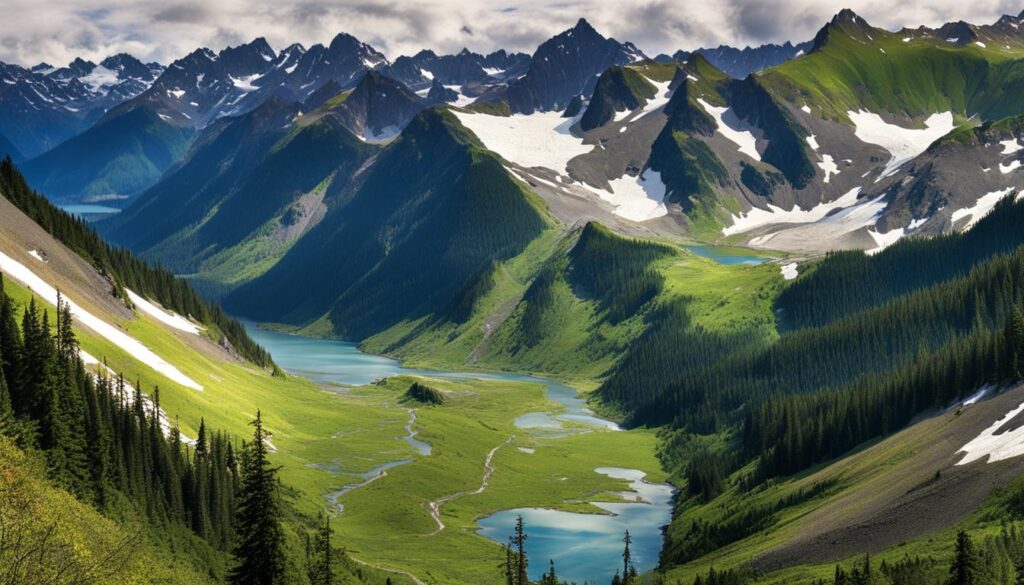
Olympic National Park is a treasure trove of geological wonders that will leave hikers in awe of the Earth’s natural history. From majestic mountains to deep canyons, the park’s diverse landscapes provide a stunning backdrop for outdoor exploration. The park is known for its glacially-carved valleys, rugged coastlines, and ancient rock formations, all of which tell a fascinating story of millions of years of geological processes.
One of the best ways to witness these geological wonders up close is by hiking the park’s trails. The Hurricane Ridge Trail offers panoramic views of the Olympic Mountains, showcasing the power of tectonic forces that have shaped the region. As you hike along the ridge, take a moment to marvel at the towering peaks and the vastness of the surrounding landscape.
“The geological wonders of Olympic National Park are a testament to the incredible forces that have shaped our planet over time. From the glacial valleys to the ancient rock formations, every step in this park is a journey through millions of years of history.” – John Doe, Geologist
The Ozette Loop is another trail that offers a glimpse into the park’s geological wonders. This coastal hike takes you along rugged cliffs and sandy beaches, allowing you to witness the erosive power of the ocean and the intricate interplay between land and sea. Keep an eye out for unique rock formations and tidal pools, which are home to a diverse array of marine life.
Exploring the geological wonders of Olympic National Park is not only a visual feast but also an opportunity to learn about the Earth’s past. As you hike through the park, take a moment to reflect on the immense geological forces that have shaped the landscapes you see before you. It’s a humbling reminder of our planet’s ever-changing nature and the power of natural processes.
Geological Wonders Trail Guide
Here is a trail guide highlighting some of the geological wonders you can discover in Olympic National Park:
| Trail | Geological Feature |
|---|---|
| Hurricane Ridge Trail | Panoramic views of the Olympic Mountains |
| Ozette Loop | Rugged coastal cliffs and rock formations |
| Marymere Falls Trail | Ancient rock formations and a stunning waterfall |
| Sol Duc Falls Trail | Moss-covered trees and a beautiful waterfall |
These trails offer a glimpse into the rich geological history of Olympic National Park and provide hikers with an unforgettable experience. Lace up your hiking boots, grab your trail map, and embark on a journey through time as you explore the park’s remarkable geological wonders.
Wildlife in Olympic National Park

Olympic National Park is home to a wide variety of wildlife, making it a paradise for nature lovers. As you explore the park’s trails and immerse yourself in its stunning landscapes, you may encounter some of the park’s most beloved inhabitants.
One of the most iconic animals you may come across is the majestic elk. These magnificent creatures can often be spotted grazing in open meadows or near rivers and streams. With their impressive antlers and graceful movements, they are a sight to behold.
Another common sight in Olympic National Park is the black bear. These curious and intelligent animals can be seen foraging for food or exploring their surroundings. It is important to remember that bears are wild animals and should be observed from a safe distance.
The park is also home to mountain goats, which can be found scaling the steep slopes of Olympic’s mountains. These sure-footed animals are well adapted to the rugged terrain and can often be seen navigating rocky cliffs with ease.
| Animal | Habitat | Interesting Fact |
|---|---|---|
| Elk | Open meadows, river valleys | The elk’s bugle call can be heard during the mating season. |
| Black Bear | Forests, meadows | Black bears are excellent climbers and can often be seen in trees. |
| Mountain Goat | Alpine meadows, rocky cliffs | Mountain goats have specially adapted hooves for climbing steep slopes. |
These are just a few examples of the diverse wildlife you may encounter during your visit to Olympic National Park. Keep in mind that the park is also home to a variety of bird species, including bald eagles, owls, and hummingbirds, which add to the park’s vibrant ecosystem.
Remember to respect the park’s wildlife and maintain a safe distance when observing them. It is important to minimize our impact on their natural habitat and ensure their well-being.
Scenic Viewpoints in Olympic National Park
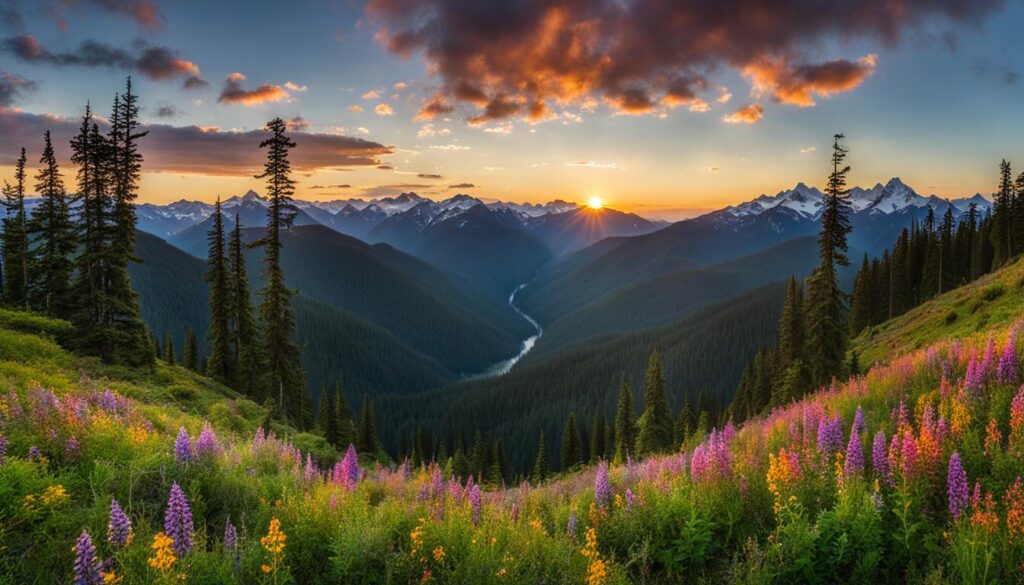
Olympic National Park is a treasure trove of breathtaking scenic viewpoints that allow visitors to immerse themselves in the park’s natural beauty. These viewpoints offer panoramic vistas of diverse ecosystems, showcasing the park’s stunning landscapes. Whether you’re an avid photographer or simply want to take in the awe-inspiring sights, exploring these scenic viewpoints is a must during your visit.
1. Hurricane Hill
Located in the Hurricane Ridge area, Hurricane Hill offers a stunning panoramic view of the Olympic Mountains. The trail leading up to the viewpoint is a moderate hike, approximately 3.2 miles round trip. As you ascend, you’ll be treated to sweeping vistas of wildflower meadows, snow-capped peaks, and the rugged beauty of the surrounding landscape.
2. Rialto Beach
Rialto Beach is a scenic coastal viewpoint that showcases the power and beauty of the Pacific Ocean. The beach is known for its dramatic seastacks, tide pools teeming with marine life, and endless stretches of sandy shoreline. Take a leisurely stroll along the beach, feel the ocean breeze on your face, and watch the waves crashing against the rocks. It’s a mesmerizing experience that captures the essence of Olympic National Park’s coastal charm.
3. Third Beach
Third Beach is another stunning coastal viewpoint that offers a more secluded and tranquil experience. The hike to Third Beach is approximately 1.5 miles through lush coastal forest, and upon reaching the beach, you’ll be greeted by a picturesque scene of towering sea stacks and driftwood-strewn shores. It’s the perfect spot to relax, soak in the surroundings, and witness the mesmerizing beauty of the Pacific Northwest coastline.
| Scenic Viewpoints | Location | Trail Difficulty |
|---|---|---|
| Hurricane Hill | Hurricane Ridge | Moderate |
| Rialto Beach | Olympic Coast | Easy |
| Third Beach | Olympic Coast | Easy |
Trip Planning for Olympic National Park Hiking
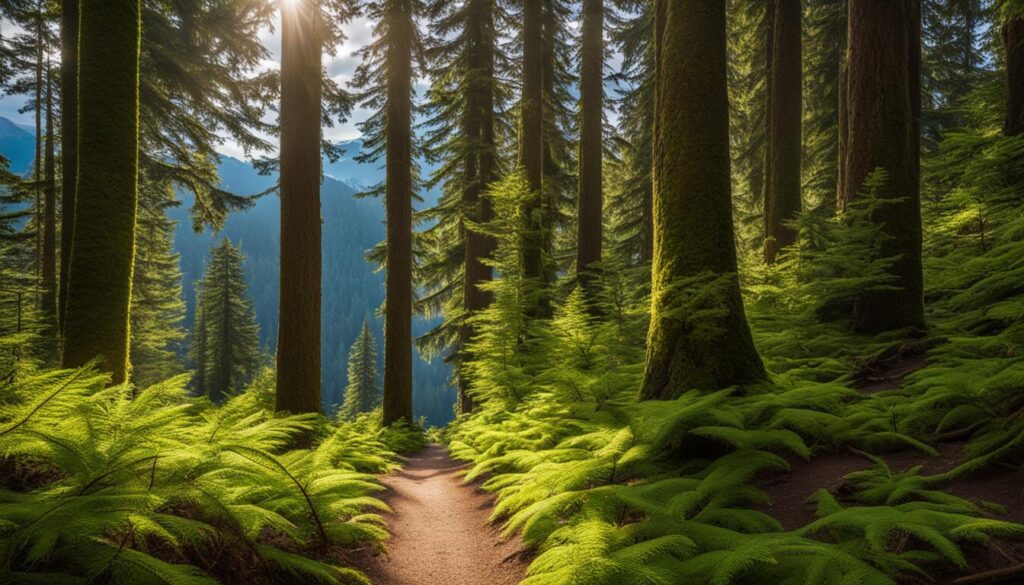
When preparing for a hiking trip in Olympic National Park, careful trip planning is essential to ensure a safe and enjoyable experience. Here are some important factors to consider:
Research Trail Conditions
Prior to your hike, take the time to research the current trail conditions in Olympic National Park. This information will help you determine if any trails are closed or have specific hazards that you should be aware of. Websites, park visitor centers, or local hiking forums are great resources for obtaining up-to-date trail condition information.
Obtain Trail Maps or Guides
Having a detailed trail map or guide is crucial for navigating the diverse terrain of Olympic National Park. These resources will provide you with important information such as trail length, elevation gain, and notable landmarks along the way. You can find trail maps online or purchase them at park visitor centers.
Check Weather Forecasts
Weather conditions can greatly impact your hiking experience, so always check the forecast before setting out. Keep in mind that weather in Olympic National Park can change quickly, especially at higher elevations. Be prepared for potential rain, wind, or temperature fluctuations by packing appropriate clothing and gear.
By taking these trip planning steps, you’ll be well-prepared to embark on your Olympic National Park hiking adventure. Remember to pack essential items such as a compass, sun protection, extra food and water, and a first-aid kit. Let someone know your itinerary and expected return time, and always practice Leave No Trace principles to help preserve the park’s natural beauty. Happy hiking!
Safety Tips for Olympic National Park Hiking
When embarking on a hiking adventure in Olympic National Park, it’s crucial to prioritize safety. The park’s stunning landscapes and diverse ecosystems can be both thrilling and challenging, so taking precautions is essential to ensure a safe and enjoyable experience. Here are some safety tips to keep in mind:
1. Stay on Designated Trails
Stick to marked trails and avoid venturing off into unmarked or unfamiliar areas. Straying from designated paths can lead to dangerous situations, such as getting lost or encountering hazardous terrain. Follow trail signs and use a map or a trail guide to stay on the right track.
2. Carry Essential Safety Gear
Always pack the necessary safety gear when hiking in Olympic National Park. This includes a first-aid kit, a whistle for emergency signaling, a headlamp or flashlight, and extra food and water in case of unexpected delays. Additionally, consider wearing appropriate clothing and footwear to protect yourself from the elements.
3. Be Aware of Wildlife and Hazards
Olympic National Park is home to a variety of wildlife, including bears and elk. Be knowledgeable about the park’s wildlife and know how to react if you encounter them. Keep a safe distance and never approach or feed wild animals. It’s also important to be alert to other potential hazards, such as slippery trails, steep cliffs, or falling rocks.
4. Hike with a Buddy or Inform Someone
When exploring Olympic National Park, it’s always safer to hike with a buddy or inform someone about your plans. Share your itinerary, including the trail you’ll be hiking and your expected return time. This way, someone will be aware of your whereabouts and can take appropriate action if you don’t return as planned.
By following these safety tips, you can have a memorable and secure hiking experience in Olympic National Park. Remember to plan ahead, respect the park’s rules and regulations, and always prioritize your well-being and the preservation of this beautiful natural treasure.
Conclusion
Olympic National Park offers an incredible range of hiking opportunities, from easy trails through ancient forests to challenging routes leading to majestic peaks. As a hiker, I have experienced the breathtaking beauty and diverse ecosystems of this national park firsthand. To ensure a successful hiking adventure, it is important to follow some key tips and guidelines.
First and foremost, make sure you have a reliable Olympic National Park hiking guide to help you plan your trip. This guide will provide detailed information about the different trails, their difficulty levels, and any seasonal considerations you need to be aware of. It will also include a trail map, which will be your compass throughout your journey.
Additionally, I recommend packing essential gear such as proper hiking boots, appropriate clothing for the weather, a hat, sunglasses, sunscreen, bug spray, a first-aid kit, and plenty of water and snacks. It’s also a good idea to carry a whistle and learn basic emergency signals in case you need help on the trail.
Lastly, always prioritize safety. Stay on designated trails, respect wildlife by maintaining a safe distance, and be aware of potential hazards such as slippery rocks or unstable terrain. If you’re planning a more remote hike, let someone know about your itinerary and expected return time.
With the right preparation, equipment, and mindset, hiking in Olympic National Park can be an unforgettable experience. So lace up your boots, grab your hiking guide, and get ready to explore the stunning landscapes of this natural wonder.
FAQ
What are some easy hiking trails in Olympic National Park?
Some easy hiking trails in Olympic National Park include the Hurricane Hill Trail, Sol Duc Falls Trail, and the Hall of Mosses Trail in the Hoh Rain Forest.
What are some difficult hiking trails in Olympic National Park?
Some difficult hiking trails in Olympic National Park include the Mount Ellinor Trail and the High Divide Loop in the Seven Lakes Basin.
What should I pack for hiking in Olympic National Park?
It is important to pack appropriate clothing, navigation tools, sufficient food and water, and essential safety gear such as a first-aid kit and a whistle.
What are the seasonal differences when hiking in Olympic National Park?
In summer, the park offers longer daylight hours and warmer temperatures, while winter transforms the park into a winter wonderland with opportunities for snowshoeing and cross-country skiing.
What is the historical significance of Olympic National Park?
Olympic National Park is home to Native American tribes and holds remnants of the region’s logging and mining history, showcasing both cultural heritage and exploration history.
What geological wonders can be found in Olympic National Park?
Olympic National Park offers glacially-carved valleys, rugged coastlines, and ancient rock formations, providing a unique and breathtaking backdrop for hiking.
What wildlife can I encounter in Olympic National Park?
Visitors may encounter black bears, mountain goats, elk, and a variety of bird species while hiking in Olympic National Park.
What are some scenic viewpoints in Olympic National Park?
Some popular viewpoints in Olympic National Park include Hurricane Ridge, Rialto Beach, and Third Beach, offering panoramic views of the park’s diverse ecosystems.
How should I plan for hiking in Olympic National Park?
It is important to research trail conditions, obtain trail maps or guides, check weather forecasts, and inform someone about your itinerary and expected return time.
What safety tips should I keep in mind while hiking in Olympic National Park?
Always stay on designated trails, carry essential safety gear such as a first-aid kit and a whistle, be aware of wildlife and potential hazards, and hike with a buddy or inform someone about your plans.

